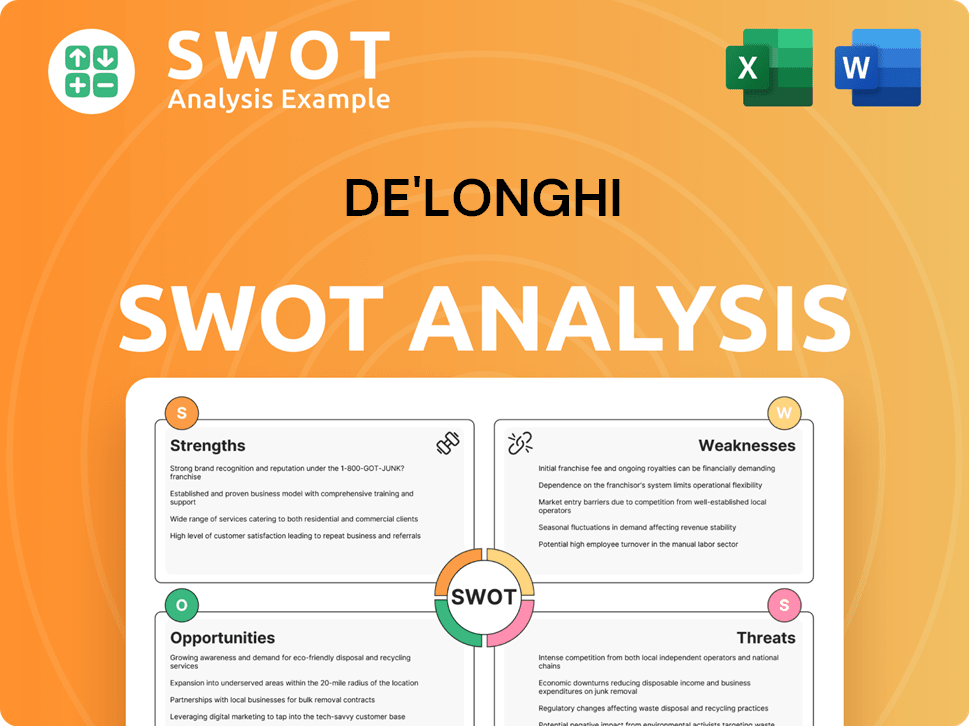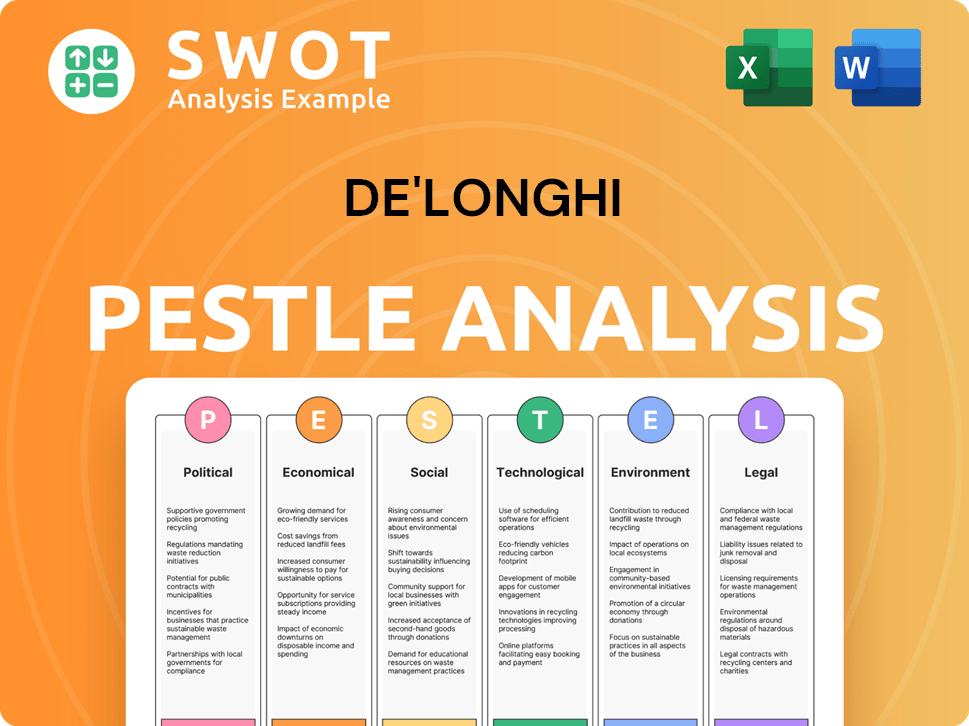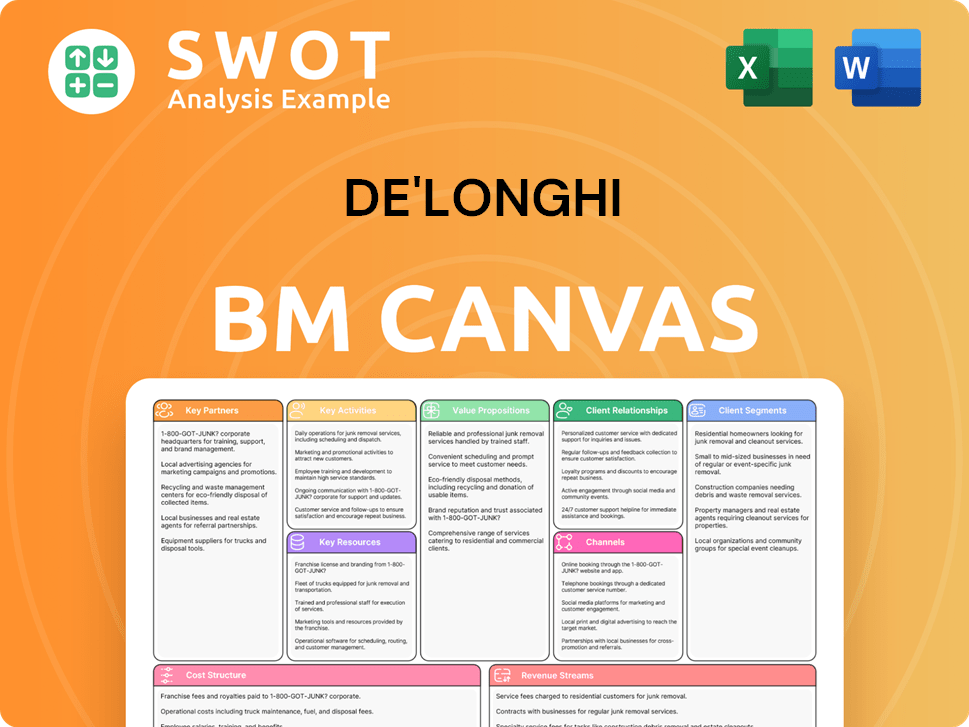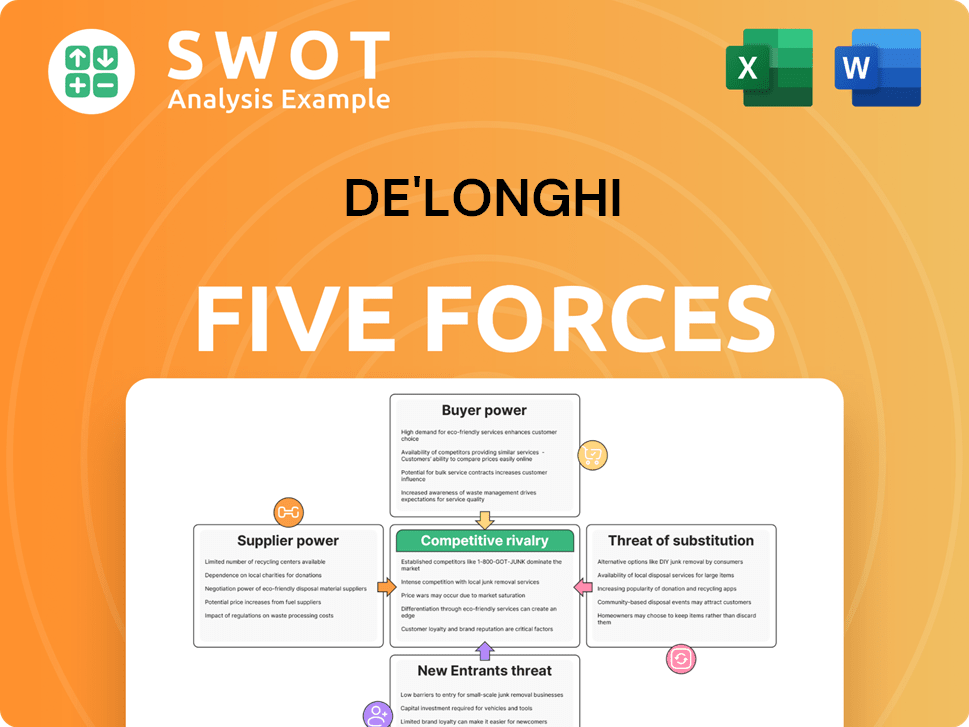De'Longhi Bundle
Who Are De'Longhi's Customers?
In the competitive world of home appliances, understanding the De'Longhi SWOT Analysis is crucial for any business. De'Longhi, a renowned Italian brand, has successfully navigated this landscape since 1902, evolving from industrial components to a global leader in kitchen appliances. This transformation underscores the importance of identifying and catering to specific customer segments. Exploring the customer demographics De'Longhi and the De'Longhi target market provides invaluable insights into the brand's success.

This deep dive into De'Longhi customer profile examines their preferences, geographical distribution, and evolving needs. We'll analyze how De'Longhi strategically adapts its product offerings and marketing campaigns to resonate with its target audience in the dynamic coffee machine market. Understanding consumer behavior and the factors influencing purchasing decisions is key to De'Longhi's continued growth and market dominance, from De'Longhi coffee machine demographics to De'Longhi customer age range and De'Longhi customer income level.
Who Are De'Longhi’s Main Customers?
Understanding the customer demographics and target market for De'Longhi is crucial for grasping its market position. De'Longhi primarily focuses on the business-to-consumer (B2C) market, with a strong emphasis on individuals and households. Their product range includes a variety of small appliances, with a notable presence in the coffee machine market.
The De'Longhi customer profile typically includes middle to high-income households, often aged between 30 and 65. These consumers value quality, design, and functionality in their home appliances. They are usually educated professionals who appreciate the convenience and experience offered by products like automatic espresso machines. The global coffee machine market, a key segment for De'Longhi, is projected to reach a value of $41.84 billion by 2028, indicating a robust and expanding customer base. This growth suggests a continuous demand for their products.
De'Longhi's strategy involves catering to diverse needs within this broad consumer segment. For instance, customers purchasing espresso machines often prioritize the ability to replicate cafe-quality beverages at home. In contrast, those buying kitchen appliances like food processors or toasters may seek durability and efficiency for daily use. The company's expansion into the fully automatic coffee machine category is driven by the increasing demand for convenience and premium coffee experiences at home. De'Longhi has also expanded its focus on younger demographics through targeted marketing and product design.
The core demographic for De'Longhi includes middle to high-income households. The age range of the customers is typically between 30-65 years old. These customers are often educated professionals.
Customers value quality, design, and functionality in their home appliances. They appreciate the convenience and experience offered by products like automatic espresso machines. There is a preference for premium coffee experiences at home.
The global coffee machine market is projected to grow significantly. The fully automatic coffee machine category is a fast-growing segment. De'Longhi is expanding its focus on younger demographics through targeted marketing.
De'Longhi's product portfolio includes espresso machines, kitchen appliances, and climate control devices. Espresso machine customers prioritize replicating cafe-quality beverages at home. Kitchen appliance customers seek durability and efficiency.
De'Longhi's success is closely tied to understanding its customer demographics and adapting to consumer behavior. The company's ability to cater to different segments within its target market is a key factor in its growth. For more details on how De'Longhi generates revenue, check out this article: Revenue Streams & Business Model of De'Longhi.
- De'Longhi customer age range typically falls between 30-65 years old.
- The De'Longhi customer income level is generally middle to high.
- The De'Longhi customer lifestyle analysis indicates a preference for quality and convenience.
- De'Longhi's market segmentation strategy focuses on product categories and demographics.
De'Longhi SWOT Analysis
- Complete SWOT Breakdown
- Fully Customizable
- Editable in Excel & Word
- Professional Formatting
- Investor-Ready Format

What Do De'Longhi’s Customers Want?
Understanding the customer needs and preferences is crucial for the success of any brand, and this is especially true for a company like De'Longhi. The company's success is deeply intertwined with its ability to satisfy a diverse range of consumer needs, from the practical to the aspirational. This focus allows the company to maintain a strong position in the competitive coffee machine market and beyond.
The customer base of De'Longhi, often referred to as the De'Longhi customer profile, is driven by a combination of factors. These include the need for efficient and user-friendly appliances, the desire for a premium experience at home, and the aspiration to align with a certain lifestyle. By addressing these multifaceted needs, the company ensures its products resonate with a broad audience.
The De'Longhi target market is not monolithic, but rather a collection of segments, each with its own set of priorities. For instance, some customers prioritize ease of use and convenience, while others place a higher value on the aesthetic appeal and craftsmanship of the appliances. The company's marketing strategies are designed to resonate with these different segments, highlighting specific features and benefits that cater to their individual needs.
Customers often seek appliances that simplify daily routines. This includes the need for durable and efficient products. For example, the ease of use of automatic espresso machines is a key selling point.
Consumers are motivated by the desire for comfort and indulgence. Owning a high-quality coffee machine can be a status symbol. The ability to create a premium experience at home is also a strong motivator.
Customers may aspire to a certain lifestyle associated with high-quality home goods. This includes the desire to align with a brand that represents craftsmanship and design. The brand's Italian heritage is a key element in this appeal.
The company addresses common pain points, such as the complexity of traditional espresso making. User-friendly automatic machines are designed to solve this issue. Multi-functional appliances cater to the need for versatile kitchen tools.
Customer feedback and market trends, such as the growing demand for sustainable and energy-efficient appliances, influence product development. The company is also influenced by the growing popularity of smart home technology.
The company tailors its marketing to specific segments by highlighting features like the LatteCrema system for coffee lovers. Specific design elements are emphasized for those prioritizing aesthetics. The company emphasizes its Italian heritage, appealing to customers who value craftsmanship and design.
Understanding the De'Longhi customer demographics is vital for the brand's success. The company must continuously adapt to changing consumer behavior and preferences. Focusing on product innovation and marketing strategies is key to maintaining market share.
- Ease of Use: Customers highly value user-friendly interfaces and automated features.
- Coffee Quality: The quality of the coffee produced is a primary driver of satisfaction.
- Durability and Reliability: Customers expect appliances to last and perform consistently.
- Aesthetic Appeal: Design and appearance play a significant role in purchase decisions.
- Sustainability: Growing consumer interest in environmentally friendly products.
De'Longhi PESTLE Analysis
- Covers All 6 PESTLE Categories
- No Research Needed – Save Hours of Work
- Built by Experts, Trusted by Consultants
- Instant Download, Ready to Use
- 100% Editable, Fully Customizable

Where does De'Longhi operate?
The company boasts a robust global presence, with significant operations spanning Europe, North America, and Asia. Its Italian roots provide a strong foothold in Europe, where it likely holds a substantial market share and brand recognition. Key markets include Italy, Germany, France, and the UK. This geographical diversity is crucial for understanding its customer demographics and target market.
In North America, the United States and Canada are vital markets for its espresso machines and other small appliances. The company has also expanded into Asia, particularly in countries like China and Japan, where there's growing demand for premium home appliances. These expansions reflect the company's strategic approach to catering to different consumer behaviors and preferences worldwide. Understanding the De'Longhi customer profile is key to its global success.
Differences in customer demographics, preferences, and buying power across these regions influence the company's localized strategies. For instance, coffee consumption habits vary significantly, leading to tailored marketing and product offerings. The company localizes its offerings by adapting product features, voltage requirements, and design aesthetics to suit regional tastes. Marketing campaigns are also localized to resonate with cultural nuances and consumer behaviors in specific countries. Recent expansions have focused on emerging markets with growing middle classes and increasing disposable incomes, while strategic withdrawals are less common given the company's established global footprint. The geographic distribution of sales indicates a strong reliance on developed markets, but increasing growth is anticipated from emerging economies. Analyzing De'Longhi customer location data helps refine these strategies.
Europe remains a core market, benefiting from its Italian heritage and strong brand recognition. Key countries like Italy, Germany, France, and the UK drive significant sales. This region showcases a mature market with established consumer preferences for coffee machines and appliances.
The United States and Canada are important markets, with a focus on premium espresso machines and small appliances. The company tailors its products and marketing to meet the specific needs and preferences of North American consumers. This includes adapting to different voltage requirements and design aesthetics.
The company has expanded its presence in Asia, particularly in China and Japan, where there is a growing demand for premium home appliances. This expansion strategy targets the rising middle class and increasing disposable incomes in these markets. The company adapts its products to suit regional tastes.
The company localizes its offerings by adapting product features, voltage requirements, and design aesthetics to suit regional tastes. Marketing campaigns are also localized to resonate with cultural nuances and consumer behaviors in specific countries. This approach is crucial for understanding De'Longhi's target market.
The company segments its market based on demographics, lifestyle, and income levels. This allows for targeted marketing campaigns and product offerings. Understanding De'Longhi customer demographics is essential for effective market segmentation.
Consumer behavior varies significantly across different regions, influencing purchasing decisions. The company adapts its marketing strategies to address these differences. Analyzing De'Longhi customer buying habits helps refine these strategies.
Product features, voltage requirements, and design aesthetics are adapted to meet regional preferences. This includes offering different models to cater to varying tastes. This approach is crucial for De'Longhi's brand success.
Marketing campaigns are localized to resonate with cultural nuances and consumer behaviors. This involves using local languages and adapting advertising messages. This helps in understanding De'Longhi consumer preferences.
The company focuses on emerging markets with growing middle classes and increasing disposable incomes. This expansion strategy aims to capitalize on new growth opportunities. This is part of the De'Longhi market segmentation strategy.
Strategic withdrawals are less common due to the company's established global footprint. This indicates a focus on maintaining and growing its existing market presence. This is a key aspect of De'Longhi's customer lifestyle analysis.
De'Longhi Business Model Canvas
- Complete 9-Block Business Model Canvas
- Effortlessly Communicate Your Business Strategy
- Investor-Ready BMC Format
- 100% Editable and Customizable
- Clear and Structured Layout

How Does De'Longhi Win & Keep Customers?
Customer acquisition and retention strategies for the company involve a blend of digital and traditional marketing efforts. The company leverages a strong online presence through its website, e-commerce platforms, and social media marketing across platforms like Instagram, Facebook, and YouTube. Influencer marketing, particularly with coffee enthusiasts and home decor influencers, also plays a role in reaching targeted demographics. Traditional marketing includes television advertisements, print media, and in-store promotions, especially in major retail chains.
Sales tactics include partnerships with large retailers and specialized appliance stores, offering product demonstrations and knowledgeable sales staff. While specific loyalty programs are not widely publicized, the company fosters retention through excellent after-sales service, including warranty support, readily available spare parts, and customer service hotlines. The company utilizes customer data, likely through CRM systems, to understand purchasing patterns and preferences, enabling more targeted marketing campaigns and personalized communication. Successful acquisition campaigns often highlight product innovation, such as new features in their espresso machines, or seasonal promotions.
Over time, the company has likely shifted more resources towards digital marketing and e-commerce given the global trend towards online shopping, impacting customer loyalty by providing convenient access to products and support, and potentially increasing customer lifetime value through repeat purchases and brand advocacy. Understanding the Marketing Strategy of De'Longhi provides further insights into their comprehensive approach.
The company utilizes a robust digital marketing strategy, including a strong online presence and e-commerce platforms. Social media marketing across platforms like Instagram, Facebook, and YouTube is employed to showcase product aesthetics and functionality. Influencer marketing is also leveraged to reach specific customer demographics within the coffee machine market.
Traditional marketing methods, such as television advertisements and print media, are still utilized. In-store promotions are also a key component, especially in major retail chains. These efforts aim to reach a broad audience and reinforce the brand's presence within the consumer behavior.
Sales tactics involve partnerships with large retailers and specialized appliance stores. Product demonstrations and knowledgeable sales staff are provided to enhance the customer experience. These strategies are designed to increase product visibility and drive sales within the target audience for the espresso machines.
Customer retention is fostered through excellent after-sales service, including warranty support and customer service hotlines. The company likely uses CRM systems to analyze purchasing patterns and preferences. This data enables more targeted marketing campaigns and personalized communication, increasing customer lifetime value.
Key metrics for acquisition and retention include customer acquisition cost (CAC), customer lifetime value (CLTV), and churn rate. These metrics help the company evaluate the effectiveness of its marketing and customer service efforts. Understanding the De'Longhi customer profile through these metrics is crucial.
- Customer Acquisition Cost (CAC): This measures the cost of acquiring a new customer.
- Customer Lifetime Value (CLTV): This predicts the net profit attributed to the entire future relationship with a customer.
- Churn Rate: The rate at which customers stop doing business with a company.
- Repeat Purchase Rate: The percentage of customers who make multiple purchases.
De'Longhi Porter's Five Forces Analysis
- Covers All 5 Competitive Forces in Detail
- Structured for Consultants, Students, and Founders
- 100% Editable in Microsoft Word & Excel
- Instant Digital Download – Use Immediately
- Compatible with Mac & PC – Fully Unlocked

Related Blogs
- What are Mission Vision & Core Values of De'Longhi Company?
- What is Competitive Landscape of De'Longhi Company?
- What is Growth Strategy and Future Prospects of De'Longhi Company?
- How Does De'Longhi Company Work?
- What is Sales and Marketing Strategy of De'Longhi Company?
- What is Brief History of De'Longhi Company?
- Who Owns De'Longhi Company?
Disclaimer
All information, articles, and product details provided on this website are for general informational and educational purposes only. We do not claim any ownership over, nor do we intend to infringe upon, any trademarks, copyrights, logos, brand names, or other intellectual property mentioned or depicted on this site. Such intellectual property remains the property of its respective owners, and any references here are made solely for identification or informational purposes, without implying any affiliation, endorsement, or partnership.
We make no representations or warranties, express or implied, regarding the accuracy, completeness, or suitability of any content or products presented. Nothing on this website should be construed as legal, tax, investment, financial, medical, or other professional advice. In addition, no part of this site—including articles or product references—constitutes a solicitation, recommendation, endorsement, advertisement, or offer to buy or sell any securities, franchises, or other financial instruments, particularly in jurisdictions where such activity would be unlawful.
All content is of a general nature and may not address the specific circumstances of any individual or entity. It is not a substitute for professional advice or services. Any actions you take based on the information provided here are strictly at your own risk. You accept full responsibility for any decisions or outcomes arising from your use of this website and agree to release us from any liability in connection with your use of, or reliance upon, the content or products found herein.